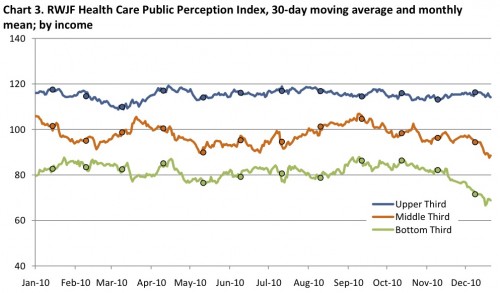We’re closing in on a year since the PPACA passed. I expect there will be a whole host of “was it worth it” stories. If they ask the average American, I’m not sure how they will respond.
That’s less a factor of the relative benefits and costs of the law than it is how they perceive it. More importantly, it’s likely going to be related to how they perceive their care. That’s because the average person will likely say, “Hey! It’s been a year! Is my health care better?” I think they will say no.
The Robert Wood Johnson Foundation monitors public perception of health care over time, taking a monthly snapshot of people’s barriers to care and concerns about affordability. They even create the “RWJF Index“, composed of the Recent Health Cost Barriers (RHCB) Index and the Future Health Cost Concerns (FHCC) Index. They poll all year long, and construct 30-day moving averages and monthly means. Over the last year, there was no significant movement, although the year ended with a lower score than it began. But here’s the chart that worries me the most:
Americans in the upper third of incomes appear to hold steady; they’re not too worried and have reasonable confidence. Americans in the middle third are more volatile, and are trending down since September. It’s the Americans in the lower third that are most concerning.
When I say lower third, remember that’s over 100 million people. The drop off since October is more than 25%. They have much, much less confidence in their health care than other Americans, and rightfully so. You don’t have to look hard to find stories of states attempting to significantly cut Medicaid funding. I wonder what the chart looks like since that started.


